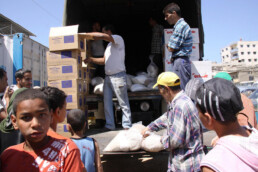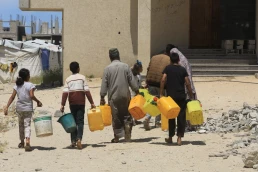Untreated sewage and overcrowding are leading to the rapid spread of disease, while three-quarters of the Strip’s hospitals have stopped functioning.
by Ibtisam Mahdi, +972 Magazine
In late November, Margaret Harris, a spokesperson for the World Health Organization, warned that without urgent action to repair the Gaza Strip’s rapidly collapsing health system, more people would soon die from disease than from Israel’s bombings. “[There are] no medicines, no vaccination activities, no access to safe water and hygiene and no food,” she said, summarizing the dire humanitarian conditions amid Israel’s ongoing bombardment and intensified siege.
Nearly a month later, the full extent of the crisis is still not being fully comprehended outside of the Strip, according to Palestinian health care professionals in Gaza. “The information, statistics, and news circulating worldwide only scratches the surface of the actual reality,” Dr. Adnan al-Wahidi, a child health expert from Gaza City, told +972. “It captures just a small fraction of the alarming health situation in the Gaza Strip.”

With Israel’s airstrikes and ground invasion forcibly displacing nearly all of the Strip’s 2.2 million residents, there is unprecedented overcrowding in parts of southern Gaza — in particular the city of Rafah, near the border with Egypt, which is still being bombed despite the Israeli army having declared it a “safe zone,” and the coastal area of Al-Mawasi where there is very little infrastructure at all. Tens of thousands of families are sheltering in flooded tent encampments, while starving children queue for hours every day at food distribution centers.
Recent Posts
“Arrest Now, Ask Questions Later”: Why Did L.A. ICE Agents Arrest and Jail U.S. Citizen Andrea Velez?
July 3, 2025
Take Action Now “They didn’t have vests that said ICE or anything. Their cars didn’t have license plates. … Just because of the color of our…
Trump’s Big, Beautiful Bill Is Naked Class War
July 3, 2025
Take Action Now Trump’s “Big, Beautiful Bill” trades tax cuts on millionaires for the dissolution of society.By Hamilton Nolan, In These Times…
Mayor Mamdani’s First Day, A Zero Hour Conversation With Richard Wolff
July 2, 2025
Take Action Now If elected, what would Mayor Mamdani do on his first day in City Hall? How would a democratic socialist govern as a big-city mayor?……
The U.S. Is Funding A Bloodbath At Gaza Aid Centers
July 2, 2025
Take Action Now The admin just gave $30M to GHF, the organization at the center of charges that Israel is weaponizing assistance and shooting at…




